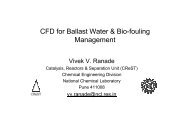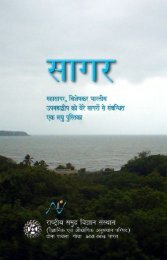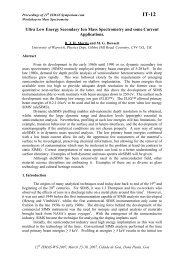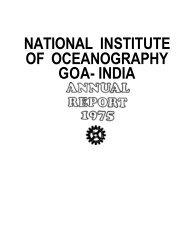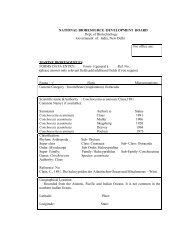1980 - National Institute of Oceanography
1980 - National Institute of Oceanography
1980 - National Institute of Oceanography
You also want an ePaper? Increase the reach of your titles
YUMPU automatically turns print PDFs into web optimized ePapers that Google loves.
4. Monitoring activities in and around Goa<br />
Monthly monitoring activities <strong>of</strong> several environmental parameters have been<br />
initiated in the rivers Mandovi and Zuari. Four stations extending from the salt water<br />
to the fresh water zones in both the rivers were sampled at mid-depth. The parameters<br />
monitored were: pH, O2, temperature, salinity/chlorinity, Ca 2+ , Mg 2+ , SO4 2- , F - ,<br />
PO4 3- -P, NO3 - -N, Hg, Mn and Fe. The last three parameters were monitored in all<br />
the three phases (dissolved, particulate and sediments)<br />
Monitoring activities were continued in the Velsao Bay also for the different<br />
forms <strong>of</strong> nitrogen compounds.<br />
5. Pollution monitoring along the Kerala coast<br />
Studies carried out under this investigation are reported separately under<br />
Section 3.8.1.<br />
6. Marine environmental monitoring along the Bombay coast.<br />
The details <strong>of</strong> this investigation are given under Section 3.8.2.<br />
3.2.4 Characteristics <strong>of</strong> the estuarine regions <strong>of</strong> major rivers <strong>of</strong> India<br />
A new multi-disciplinary project to survey the environmental features in the<br />
estuarine region <strong>of</strong> 7 major Indian rivers was initiated during the year. One set <strong>of</strong><br />
observations has been completed in September, <strong>1980</strong> in the estuarine region <strong>of</strong> the<br />
river Hooghly, from Diamond Harbour to Sandheads (a distance <strong>of</strong> approximately<br />
60 nautical miles) and also at a station <strong>of</strong>f the mouth <strong>of</strong> the river Mahanadi.<br />
Each station was worked over a tidal cycle <strong>of</strong> 12 hours to measure temperature,<br />
salinity, current speed, current direction, dissolved oxygen, phosphate-phosphorus,<br />
nitrate-nitrogen, ammonia.-nitrogen and suspended solids. The nutrients, dissolved<br />
oxygen and suspended solids were measured at individual collection every 3 hours<br />
at 3 depths. A composite sample at mid-depth over the tidal period was also collected.<br />
Current direction at the Diamond Harbour was SE-NNW (134°-344°) turning<br />
210° over the tidal cycle. The values at Haldia were SE-ENE (222°-071°) turning<br />
151° and at Sagar SW-SSE to N-NNE (192°-011°) turning 179° over the tidal cycle.<br />
This shows that the currents turned almost 180° at all the stations. At the Diamond<br />
Harbour and Haldia, salinity values were 0.09 and 0.8l%o respectively, while at Sagar<br />
during the ebb tide, a layer <strong>of</strong> low salinity water <strong>of</strong> about 8%o was observed in<br />
the upper 7 metres. Similarly a layer <strong>of</strong> a higher salinity water <strong>of</strong> about 14%o upto<br />
15 metres depths was observed.<br />
Comparing the nutrient values with tidal fluctuation, it was observed that in<br />
general, at all the 3 stations, the values were higher during the ebb tide and lower<br />
during the flood tide indicating a net transport <strong>of</strong> the nutrients seawards. However,<br />
a proportionate increase <strong>of</strong> these values was not observed at the Sandheads station. This<br />
probably indicates that a major portion <strong>of</strong> the nutrients along with the enormous<br />
35



